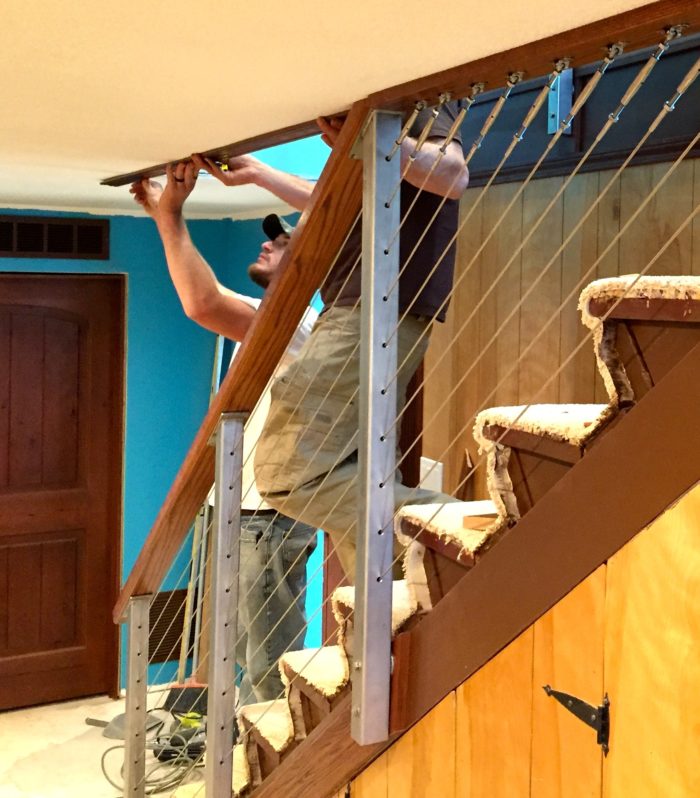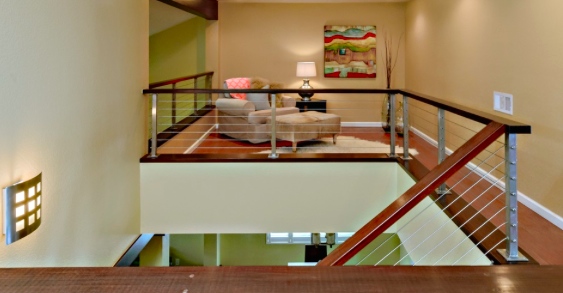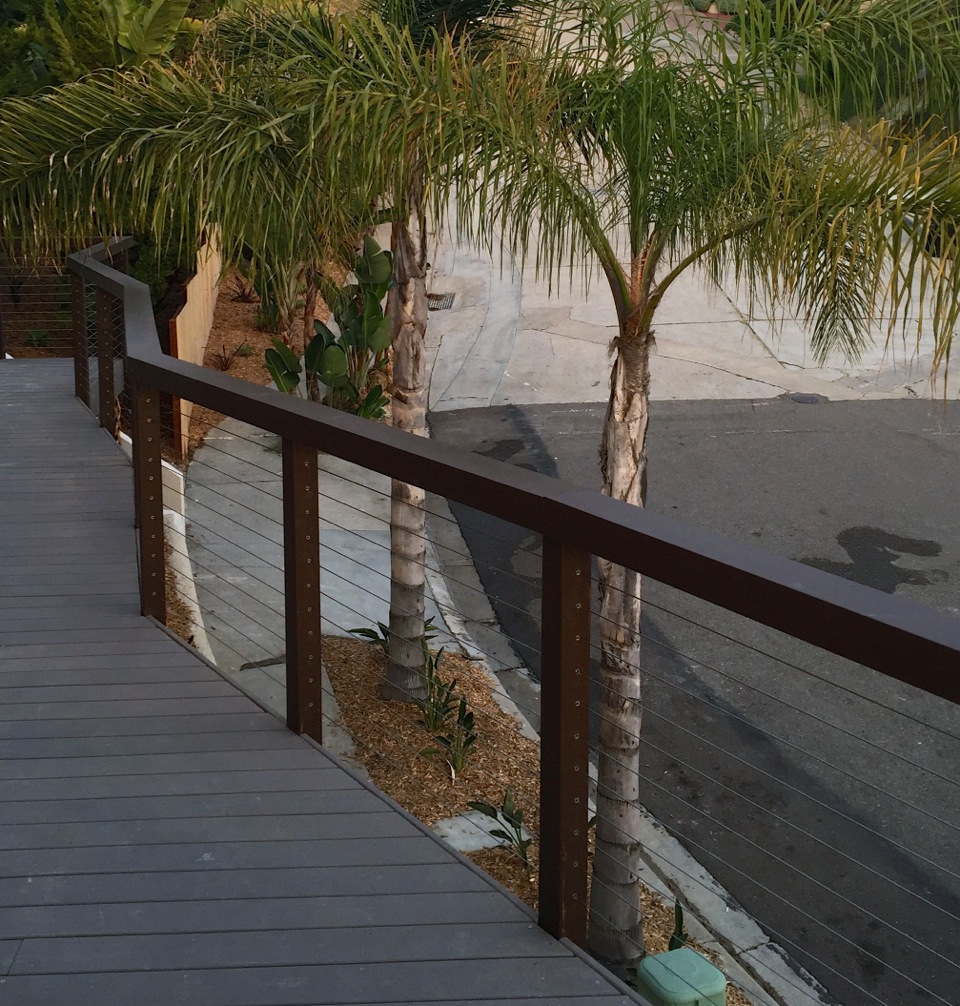



Pro Tips for Sizing and Installing Grab Rails at Your Home With some accurate measurements and a couple of tricks, installing a grab railing is a great DIY project and a valuable home improvement. A “grab rail” is a continuous section of handrail used to provide support when ascending and descending a set of stairs. Installing a grab rail can be an attractive and functional addition to your stairs. It will provide a graspable support and a nice design element at a low cost. If you’re looking to install a new grab rail or replace an old one; here are a couple of tips to get you started: Locate your studs– Using a stud finder, magnet or pilot pin, locate the studs on the wall where you plan to install your railing. Purchasing grab rails online could require you to specify the number of brackets needed to support the rail. Installing them directly into wall studs will provide the best connection. A bracket every 32″-48″ should be enough to secure a steel or hardwood grab rail if the brackets are secured to studs. Measure the wall section exactly! –If you plan to purchase a steel or stainless steel grab rail, the return ends will be welded on during fabrication. This means your measurements need to be dead on. Pro tip – measure up from the nose of the top and bottom stair using a plumb line or level and mark the location above each stair (somewhere between 34″-38″ is code required height). Then snap a line on the two marks so you can measure on the exact angle of the grab rail. Use drywall anchors if needed– If you are unable to locate enough studs or the layout does not accommodate your railing section, you can use drywall anchors for extra support. Just mark the hole locations and install the anchors behind the bracket locations. It is not recommended to screw brackets into drywall without a proper anchor. Drywall is not designed to be a structural support. New construction projects with stairs or any permitted stairway remodeling projects will almost always require the installation of a grab rail. Some stairways require installation on both sides of the stairs while others only require a graspable rail on one side only. Sometimes during the home purchase process insurance companies or home inspections will require the installation of graspable railings. San Diego Cable Railings furnishes hardwood, steel and stainless steel grab rails for professional and DIY installations nationwide. We offer standard length sections (8′, 10′, 12′) and custom fabrication for non standard installations. For customers requiring professional installation we also have licensed contractors who specialize in code compliant railing installs. If you have questions about any of our grab rail products or would like a quote for graspable railings; visit the quote request page today! [ec_store modelnumber=”Ipe-Grab-Rail”]

Hiring Cable Railing Contractors- Finding the right contractor for a home remodeling project can be challenging, however it is a very important step to starting a renovation. The right trade specialist can make a huge impact when it comes the the end results of any installation. In this weeks blog we will provide some tips about hiring a contractor, and share some of our own experience from working with hundreds of contractors across the country. -Hire A Specialist Hiring a specialty contractor means they should be expert level providers of the products and services that are being offered. Some good examples of specialty contractors are window installers, deck builders, and roofers. These trades typically stick to the specialized type of work they perform. For example: the window installer is not likely a good candidate for your paid cable railing installation; even if they did a great job on your windows. A deck builder or carpenter who has performed several cable railing installations on previous jobs could be a great find. Don’t hesitate to ask contractors for photos of previous projects, web addresses or even reviews from previous customers. Choosing a contractor over a DIY application should mean hiring a true PRO. -Product Knowledge Cable railing contractors should have knowledge about the products they are installing. Nobody desires to pay a premium for a contractor to learn on the job. Your contractor should be able to educate you about the products and installation that is being performed. A good contractor will make you feel comfortable providing information about the questions you may have. It’s OK to ask questions and its always better to ask them before the project starts. -Payment Licensed contractors should not ask for much money up front. In California a 10% deposit is the maximum amount allowed prior to performance of any work. A request for a 50% down payment is illegal and likely a huge red flag. Good contractors manage jobs and finance their own projects. Larger jobs may require progress payments but you should never pay a large amount of money before the work is performed. -Get a Referral Referral based business is still one of the best ways to find good contractors. At San Diego Cable Railings we have preferred contractors in San Diego, Los Angeles and the San Francisco Bay area. If you are interested in a contractor referral please give us a call or submit a quote request today. 1-844-277-7327 –
DIY deck railings can offer significant cost savings for do it yourselfers, but how do you know when it’s time to hire a pro? San Diego Cable Railings has you covered! Our professional sales and production staff combines expert product knowledge and preferred contractor referrals to deck railing specialists. This weeks blog post contains a few examples of common building conditions for both DIY and professional installation. -Ground level decks and straight line scenarios are great candidates for DIY deck railings. Cable fencing projects can also be a common DIY scenario because few specialty tools are required. Many homeowners have built a fence or two; and with a few tricks cable fencing can be done easily and effectively. Lower elevations mean safer working conditions and working on flat ground is less intimidating to novice installers. Wooden posts and rails are less expensive and typically more forgiving than steel. Raised decks, balconies, and structural retrofit projects are more commonly installed by professionals. Skilled deck builders and cable railing installers understand the framing components and loads associated with these types of structures. Construction performed at 10-20 feet off the ground requires a certain skill set, and can be dangerous without proper tooling and fall protection. San Diego Cable Railings preferred contractors have constructed hundreds of decks and railings all over California. It is important to remember that there is no “one size fits all” scenario when it comes to cable railings and deck construction projects. Homeowners and contractors must evaluate the challenges and practicality of each individual project, as well as the skill level of the installer. Our pre made cable railing kits provide detailed instructions and swage less cable fittings for DIY install with minimal tools. For more complex installations we offer accurate installation estimates and referrals to trained professionals. We recommend using licensed contractors that have specific experience with our products to ensure safety and success. If you have questions about DIY deck railings or cable railing installers, give us a call or visit the quote request page today! 844-277-7327

Custom cable railings consist of railing frames, cable assemblies, colors and finishes that can require unique considerations to achieve a standard 36″ or 42″ railing requirement. While the term “custom” may be associated with difficulty, complexity, or even cost; custom cable railings can be made to be simple and easily modulated for DIY or professional installation by San Diego Cable Railings. Our custom cable railing kits can be modified to meet the needs of a variety of clientele and building challenges. The following list contains a few good examples of some common custom cable railing scenarios: Stair Railings- Cable railings for stairs commonly require angled mounting plates and off set perforations to properly accommodate unique building conditions that exist on these types of installations. Cable hardware for stairs is different than hardware for straight runs, and may require surface mounted cable fittings or angled washers. Wall Mounted Cable Railings- Cable railings mounted to angled or level pony walls, knee walls, or curbs may require modified post dimensions and mounting plates for proper attachment. Proper backing and the use of masonry anchors or stainless steel lag bolts may be necessary for these type of installations. Custom finishes and Specialty Coatings– One of the many benefits of purchasing from cable railing professionals is the ability to deviate from “cable in a bag” or “choose from 5 popular colors”. Large chain stores and online companies cannot customize cable assemblies or offer 100’s of colors and finishes. At San Diego Cable Railings we can mix and match materials and finishes, and design cable assemblies for even the most unique conditions. Do you have questions about custom cable railings? Need help finding railing posts cable assemblies and hardware for your railing project? Need an estimate on a custom cable railing kit? Give us a call at 844-277-7327 Today!

“Utilizing Stainless Steel Protector Sleeves” Cable railing installation tips for wooden cable railings: A popular and cost effective choice for constructing cable railings, and cable fences. Wood framing is typically a warmer and more natural feel for those rustic or landscape style railing applications that do not call for more contemporary stainless steel railing posts. Despite the cost benefits, wood posts do require different considerations for a successful cable railing installation. Wood selection and wood types will play a large role in the longevity of a cable railing system. Common exterior wood types include western red cedar, redwood, douglas fir, and Ipe Brazilian hardwood. Timbers should contain minimal knots, and feature tight grain whenever availability permits. Clear timbers are typically stronger than construction grade timbers. One simple and inexpensive way to add durability to wooden cable railing posts is by utilizing stainless steel sleeves inside the cable perforations. Stainless steel protector sleeves will assure that when turning a corner, bending, or traveling through jigs and jogs, the cable does not “bite”into wood framing members. “Biting” can result in loss of cable tension or damage to wood railing posts. In addition to the added protection, the cables will tension faster and react against a hard stainless steel sleeve vs. a softer wooden post. Stainless steel protector sleeves also help by reducing moisture intrusion, and provide a more finished look than bare wood perforations. Even hardwood posts like Ipe and Mangaris require stainless sleeves when bending occurs. San Diego Cable Railings offers stainless steel sleeves for a la carte purchase at the online store. Our preferred installers utilize stainless steel protector sleeves on all wood framed cable railing applications. If you have questions about stainless steel protector sleeves please visit www.sandiegocablerailings.com or call us at 844-277-7327. Cable Railing Installation Tips: utilizing stainless steel cable and protector sleeves: